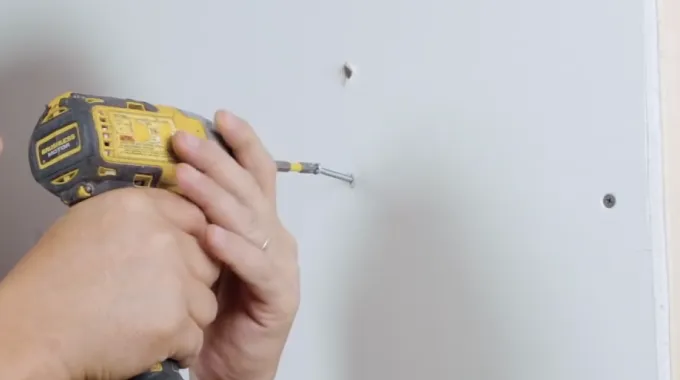Last Updated on January 20, 2023
Hanging drywall has unique needs, so you don’t want it coming down in one swift gust. For tackling a DIY drywall project, one of the biggest questions often arises, “can I use wood screws in drywall?”
You can actually go with wood screws if you pick the right type. Just make sure they’re specifically made for drywall otherwise, all your hard work might come tumbling down.
It requires careful consideration of size and complexity, the load-bearing capacity, and the layers/thickness of drywall involved. Plus, factors like dimension & thread count compatibility as well as user experience, must be factored in before proceeding.
Wood screws add strength and durability, plus they’re fast to install. But beware, you may find yourself fighting corrosion or needing to remove those tricky little devils down the line.
We’ll help you traverse these bumpy roads by guiding you toward top-notch wooden screw types that are perfect for any situation. Let’s go!
Whether to Use Wood Screws In Drywall Or Not: Factors to Consider

When considering installing wood screws in drywall, there are various factors to take into account. We will explore the different types of projects, wallboard materials, Length & thread, and levels of experience needed for using wood screws in drywall.
By understanding these essential elements, you can make an informed decision as to whether wood screws are the right choice for you.
Type Of Project:
When it comes to drywall wood screws or not, one of the most important factors to consider is the size and complexity of the project, as well as its load-bearing capacity.
Wood screws are generally best suited for small projects that don’t require an excessive amount of structural support. If a project requires more structural support than what can be provided by a single screw, then another type of fastener may be necessary.
If the project is large or complex enough to require a lot of screws, then using wood screws may not be practical due to their small size compared to nails and anchors.
Type Of Wallboard Used:
The thickness and number of layers used in the wallboard will also affect whether wood screws should be used in drywall or not. Thinner wallboards may have less resistance against pullout from wood screws than a thicker board does.
When constructing multiple layers with materials such as plywood and gypsum board, wood screws may struggle to penetrate the extra material making them far less stable. To ensure a sturdy build, it is best to use other fasteners, such as drywall screws, nails, or anchors instead.
Length & Thread:
The length and thread count on a screw can also influence whether it should be used in drywall projects. Longer screws usually provide more holding power, but they also take longer to install, meaning they won’t be suitable for any quick jobs where speed is essential.
On the other hand, shorter screws might not provide enough holding power for heavier loads and could result in loose connections over time which could eventually lead to failure down the line.
Level Of Experienced Needed:
It’s very important to understand your own level of experience when attempting any DIY project involving wood screws in drywall. We recommend that professional help is sought out if you don’t feel confident enough in your abilities to carry out the task yourself safely and properly.
Even if you plan on undertaking this job yourself, then it would still be advisable to consult an expert who can provide advice on best practices and materials needed for the job.
This way, you can reduce any potential safety risks associated with incorrect installation methods or inadequate hardware selection which could result in costly repairs.
Types Of Wood Screws Best Suited For Drywall Applications
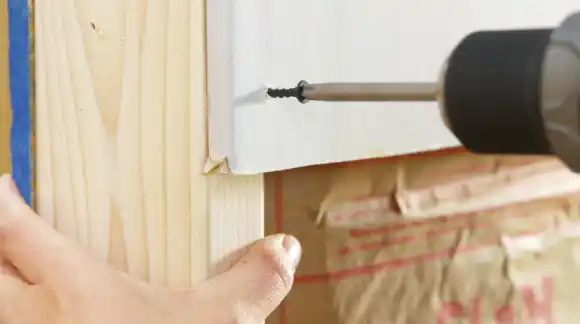
Depending on the desired result and material being secured, wood screws come in a variety of types. We will discuss the five most commonly used wood screws and their best applications when working with drywall.
Round Head Wood Screws:
Round head wood screws offer the perfect combination of aesthetics and efficiency for drywall projects.
With a classic, rounded look that won’t damage sheetrock, these sturdy little screws provide ample grip and strength to ensure your walls remain smooth with an impeccable finish.
Perfect for cabinetry or other decorative purposes, round head wood screws are reliable fasteners no matter the project!
Truss Head Wood Screws:
Truss head wood screws feature an inverted bowl-like shape which is perfect for applications where aesthetics are important because they can easily be countersunk into the drywall surface, resulting in a flush finish after installation.
This makes them great for jobs like hanging cabinets or shelving units where you don’t want visible screws sticking out from the wall.
The truss design also offers good holding power and minimal slipping as there is plenty of material within the head to grip onto when tightening down two pieces into place.
Pan Head Wood Screws:
Pan head wood screws have a low profile design with a broad top surface which helps ensure that they won’t break through the surface layer when driven into drywall material. This design makes them great if you are looking to keep your project looking neat and tidy without any unsightly holes left behind.
The pan shape also provides good torque when tightened down which keeps everything firmly secured together with minimal effort required from you during installation.
Buglehead Wood Screws:
Buglehead wood screws are the perfect choice for heavier home projects. Their unique shape ensures that they won’t damage or tear your drywall, making them ideal for building frames and mounting heavy items like speakers and electronics onto gypsum board walls!
The buglehead shape also has self-tapping threads which make driving these particular screws into even harder materials easier too. It allows you to get your job done quickly whilst still getting quality results every time.
Advantages of Using Wood Screws in Drywall

Wood screws offer several advantages over other types of fasteners, including increased strength and durability, faster installation process, strong holding power for heavier objects on thin sheetrock, and improved long-term results. Let’s discuss 3 benefits of using wood screws in drywall in more detail.
Increased Strength and Durability:
Wood screws provide excellent strength and durability in drywall. The sharp threads ensure that the screw penetrates deep into the material and securely attaches it to the wall.
Unlike nails or other fasteners which can easily pull out from the material over time, screws provide a much stronger hold which won’t loosen even with regular use or vibrations.
Additionally, since wood screws are made from metal alloys such as steel or brass, they are highly resistant to corrosion and rusting which makes them ideal for outdoor applications as well.
Faster Installation Process:
They significantly reduce installation time compared to nails or other fasteners.
Since they require no pre-drilling or hammering like nails do, they can be installed much faster without sacrificing quality or reliability. This makes them an ideal choice for those who need to finish their project quickly without compromising on quality.
Superior Holding Power for Heavy Objects on Thin Sheetrock:
Wood screws offer unbeatable grip on thin drywall, making them ideal for securing heavier objects such as cabinet handles and trimming.
The sharp threads penetrate deeply into the material providing a secure hold that won’t loosen over time even when supporting items weighing up to several pounds. As such, they are ideal for areas where heavier items will be placed such as kitchen cabinets, bathroom vanities and furniture pieces around your home.
Disadvantages of Using Wood Screws in Drywall
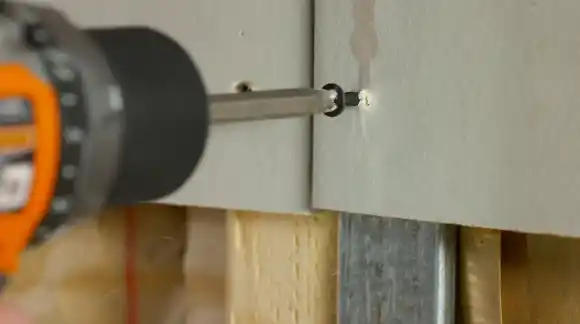
Using wood screws in drywall 2 distinct disadvantages, including being prone to rust and removing & replacing the screw is more difficult. We will discuss these drawbacks so that builders, contractors, and homeowners can make an informed decision.
Prone to Rusting with Excessive Water Exposure:
Using wood screws in drywall is that they can easily rust if exposed to excessive water or moisture in the air. Wood screws are made from plastic, metal alloys such as steel, zinc-coated steel, aluminum alloy, and brass, which are all prone to rust if exposed to water.
When wooden posts and beams become wet due to rain or high humidity levels, the metal components of wood screws will corrode over time, leading to weakened structural integrity.
This corrosion can cause paint chipping off and discoloration on walls and other surfaces where wood screws have been used. Rusting may also lead to weakened joints where two pieces of material come together.
Increased Difficulty in Removing or Replacing the Screw:
While wood screws provide a strong bond between two pieces of material when properly installed, removing them may take extra effort depending on several factors, such as material type and weather conditions.
What’s the difference between wood screws and drywall screws?
Before beginning your carpentry project, you should consider the differences between wood and drywall screws. Wood screws are suited for attaching various materials together, while drywall screws have specifically been designed to be used with metal or wooden studs.
Knowing these distinctions will ensure you select the best fastener option for your particular needs.
Coarse Thread and Shank:
Wood screws will typically feature a partly-threaded shaft and a thicker shank than drywall screws. This makes them better at holding together heavy objects like furniture because they provide greater grip over a larger area.
Drywall screws, on the other hand, are usually fully threaded and feature a thinner shank. This gives them more flexibility when securing lightweight items such as drywall sheets or panels since the thin shank allows them to be driven into tighter spaces without damaging the fastening material.
Durability:
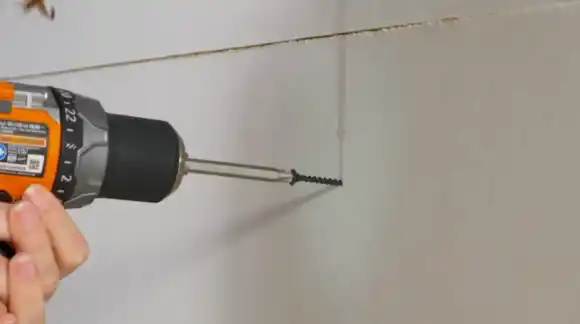
In terms of durability, a wood screw tends to be relatively strong and more flexible than a drywall screw. The thicker shank helps reduce shearing forces on the screw when exposed to high levels of torque or pressure from expansion during tightening, making it less likely to break.
Drywall screws, however, are much weaker due to their thin profile and lack of flexibility. When exposed to too much torque or pressure, they can easily snap off in their holes.
Shape:
Wood screws may appear as traditional round heads, but they also come in a variety of shapes like flat or oval. These shapes allow for various levels of gripping power depending on your needs.
Drywall screws have a bugle-shaped head which provides an optimal amount of grip but won’t damage the surface material being fastened. This makes them ideal for light jobs where precision is necessary but not excessive force is required.
Material:
While both may be made out of either steel or stainless steel alloys, respectively, their composition can vary greatly depending on what they’re meant to do. Wood screws tend to feature more resilient coatings such as zinc plating or black oxide finishes which provide increased corrosion resistance.
Drywall screws may contain softer metals like aluminum which are better suited for lighter jobs like attaching plasterboard walls or ceiling panels without causing any damage due to overtightening.
Do you Need to Drill Pilot Holes on Drywall for Wood Screws?
When securing a screw into drywall, it’s always best to start with a pilot hole. This ensures the screw is perfectly placed and can take hold without any added strain on the wall.
To determine what size drill bit you’ll need for this job, remember that anything under 1/4 inch should use an ordinary drill bit, but if your screws are bigger, then go ahead and opt for one larger than its shank.
Are Wood Screws Only Used on Wood?
Wood Screws are much more than just for wood. They offer versatility and are so strong they can penetrate hard surfaces like metal, plastic, or drywall without damaging them. From DIY projects to furniture-making to general construction tasks.
Can You Screw into Drywall without a Stud?
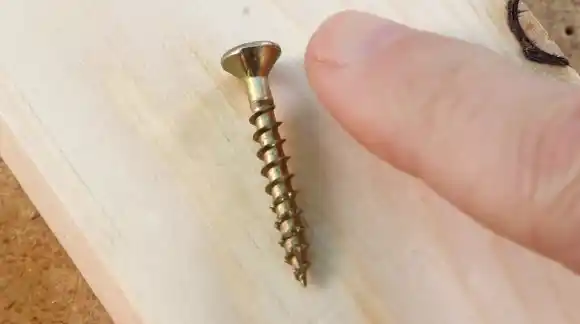
Keep your wall hanging securely without worry, even in drywall with no studs! Wood anchors twist into the walls for a dependable grip that won’t let go, perfect when you need to hang something up but don’t have access inside.
When installing anchors, it’s important to choose one that meets your requirements and is suitable for the weight load you want it to support. This could range from light-duty anchors up to heavy-duty ones depending on what needs fixing up.
How Much Weight Can a Screw Hold in Drywall without a Stud?
Drywall screws might look small, but they pack a surprisingly large punch. Most are designed to hold between 15-20 lbs when firmly installed with a wood stud. But size and length matter too: longer screws usually provide more power yet require greater care for longevity.
Use the Right Wood Screws for Your Drywall Projects for Superior Durability
Wood screws can be a great choice for fastening drywall as they provide superior holding power and durability. However, there are several factors that need to be taken into consideration before making your decision.
These include project size and complexity, load-bearing capacity, layers of the wallboard being used, dimensions of the screw being used, substrate compatibility, and level of experience working with wood screws.
Additionally, there are different types of wood screws that can be used for drywalling applications such as round-head wood screws, truss-head wood screws, pan-head wood screws, bugle-head wood screws, and flathead wood screws. With all these points in mind, you should now have a better idea of whether or not using wood screws in drywall is right for your project.
